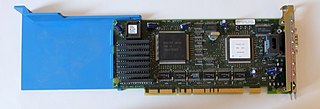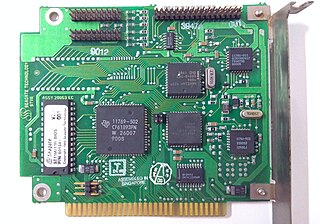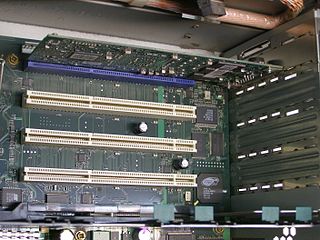
Small Computer System Interface is a set of standards for physically connecting and transferring data between computers and peripheral devices, best known for its use with storage devices such as hard disk drives. SCSI was introduced in the 1980s and has seen widespread use on servers and high-end workstations, with new SCSI standards being published as recently as SAS-4 in 2017.

The Amiga 2000, or A2000, is a personal computer released by Commodore in March 1987. It was introduced as a "big box" expandable variant of the Amiga 1000 but quickly redesigned to share most of its electronic components with the contemporary Amiga 500 for cost reduction. Expansion capabilities include two 3.5" drive bays and one 5.25" bay that could be used by a 5.25" floppy drive, a hard drive, or CD-ROM once they became available.

The ST-506 and ST-412 were early hard disk drive products introduced by Seagate in 1980 and 1981 respectively, that later became construed as hard disk drive interfaces: the ST-506 disk interface and the ST-412 disk interface. Compared to the ST-506 precursor, the ST-412 implemented a refinement to the seek speed, and increased the drive capacity from 5 MB to 10 MB, but was otherwise highly similar.

Micro Channel architecture, or the Micro Channel bus, is a proprietary 16- or 32-bit parallel computer bus introduced by IBM in 1987 which was used on PS/2 and other computers until the mid-1990s. Its name is commonly abbreviated as "MCA", although not by IBM. In IBM products, it superseded the ISA bus and was itself subsequently superseded by the PCI bus architecture.

The disk controller is the controller circuit which enables the CPU to communicate with a hard disk, floppy disk or other kind of disk drive. It also provides an interface between the disk drive and the bus connecting it to the rest of the system.
In computing, ASPI is an Adaptec-developed programming interface which standardizes communication on a computer bus between a SCSI driver module on the one hand and SCSI peripherals on the other.

In computer hardware, a host controller, host adapter, or host bus adapter (HBA), connects a computer system bus, which acts as the host system, to other network and storage devices. The terms are primarily used to refer to devices for connecting SCSI, SAS, NVMe, Fibre Channel and SATA devices. Devices for connecting to FireWire, USB and other devices may also be called host controllers or host adapters.

PCI-X, short for Peripheral Component Interconnect eXtended, is a computer bus and expansion card standard that enhances the 32-bit PCI local bus for higher bandwidth demanded mostly by servers and workstations. It uses a modified protocol to support higher clock speeds, but is otherwise similar in electrical implementation. PCI-X 2.0 added speeds up to 533 MHz, with a reduction in electrical signal levels.

Adaptec, Inc., was a computer storage company and remains a brand for computer storage products. The company was an independent firm from 1981 to 2010, at which point it was acquired by PMC-Sierra, which itself was later acquired by Microsemi, which itself was later acquired by Microchip Technology.

The LTE is a line of laptops manufactured by Compaq Computer Corporation, introduced in 1989 and discontinued in 1997. It was the first notebook-sized laptop sold by Compaq and the first commercially successful notebook computer, helping launch the burgeoning industry.

The Amiga 1200, or A1200, is a personal computer in the Amiga computer family released by Commodore International, aimed at the home computer market. It was launched on October 21, 1992, at a base price of £399 in the United Kingdom and $599 in the United States.
The Advanced Disc Filing System (ADFS) is a computing file system unique to the Acorn computer range and RISC OS-based successors. Initially based on the rare Acorn Winchester Filing System, it was renamed to the Advanced Disc Filing System when support for floppy discs was added and on later 32-bit systems a variant of a PC-style floppy controller.

Reply Corporation, often shortened to Reply Corp., was an American computer company based in San Jose, California. Founded in 1988 by Steve Petracca, the company licensed the Micro Channel architecture from IBM for their own computers released in 1989, competing against IBM's PS/2 line. The company later divested from offering complete systems in favor of marketing motherboard upgrades for older PS/2s. Reply enjoyed a close relationship with IBM, owing to many of its founding employees, including Petracca, having worked for IBM. The company was acquired by Radius in 1997.
Pacific Cyber/Metrix, Inc. was an American computer company based in California. The company was founded in 1975 in San Ramon, California.

Cumulus Corporation was an American computer peripheral and system manufacturer active from 1987 to 1993. Based in Beachwood, Ohio and started by Tecmar founder Martin Alpert, the company set out to exclusively manufacture expansion products for IBM's Personal System/2 (PS/2) family of computers—mainly RAM expansion cards. It later released cross-platform CPU upgrade cards and memory expansion cards for other platforms besides the PS/2. Beginning in 1990, the company began trading as Cumulus Computer Corporation and began releasing complete systems of their own. Initially a success story for the tech industry in Cleveland, a botched stock launch in 1992 proved disastrous for the company's ailing cash flow situation, and in 1993 the company was liquidated amid massive debt to suppliers and lenders.

BusLogic, Inc., was an American computer company active from 1988 to 1996. It specialized in the production of Small Computer System Interface (SCSI) device controller chips and controller expansion cards, becoming a dominant player in that market, behind only Adaptec. In 1996, the company was acquired by Mylex Corporation.
New Media Corporation, also known as New Media Technology Corporation, was an American computer company active from 1992 to the early 2000s. The company focused on the design and manufacture of PC Cards, a type of expansion card bus for laptops that had their heyday from the early 1990s to the mid-2000s. New Media was privately held and based out of Irvine, California.
Actix Systems, Inc., was an American graphics adapter manufacturer active from 1990 to 1998 and based in the San Francisco Bay Area. The company was founded by Stephen W. Cheng and initially specialized in a subset of graphics adapters known as GUI accelerators, becoming a major player in the field. Toward the mid-1990s the company began manufacturing more general-purpose adapters under their GraphicsEngine brand.

The LTE Elite was a series of notebook-sized laptops under the LTE line manufactured by Compaq from 1994 to 1996. All laptops in the LTE Elite range sported Intel's i486 processors, from the 40 MHz DX2 to the 75 MHz DX4. The LTE Elite was the first notebook-sized laptop to house the AC adapter inside the case itself, eliminating the need to carry an external power brick. The LTE Elite line was replaced by the LTE 5000 series in 1995. Compaq ceased manufacturing the LTE Elite line in March 1996.
MiniStor Peripherals, Inc., was a public American computer hardware company based in San Jose, California, and active from 1991 to 1995. The company was the first to manufacture and market PC Card spinning hard drives, based on the 1.8-inch hard drive specification invented earlier by Intégral. The company briefly rode a wave of success in this market before dissolving amid bankruptcy proceedings in April 1995.














